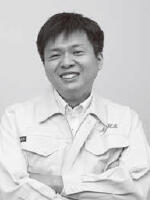Research and Development Directorate
Immediately Ascertaining Conditions on the Ground When Disaster Strikes
Satellite Gyro Sensor
Using Cutting-Edge Technology
The Research and Development Directorate is striving to develop a satellite camera system with a large telescope on the geostationary orbit that allow satellites to immediately and continuously observe ground conditions when disasters occur. To point the large telescope at a ground target point and take imageries without any camera shake, a device called a gyro sensor that can ascertain the satellite's orientation (attitude) is needed. Heretofore a mechanical spinning gyro has been used, but there will come times in future when vibrations due to spinning will have an impact on observational data. Gyroscope sensors, called "fiber-optic gyros," are attracting attention as a means to solve this problem.
MITANI Shinji, involved in this research, noted: "A fiber-optic gyro is a sensor that applies the theory that light travels at a constant speed, and such gyros are being used on trains, ships, aircraft and elsewhere."
"Two light powers are injected into a looped fiber-optic coil and branched, one traveling clockwise and the other counter-clockwise, and the phase shift in the respective light waves is measured to detect changes in attitude. Because they do not have "moving" parts like the rotor in mechanical spinning gyros, fiber-optic gyros offer the significant benefit of vibration-free operation."
The Research and Development Directorate has been working to advance this technology, pursuing the development of a "multi-core fiber gyro," the world's first fiber-optic gyro utilizing multi-core fibers (MCFs).
"MCFs are optical fibers with multiple cores (paths along which light travels) in a single strand. The coil of fiber-optic gyro using a MCF can be made shorter than the coil using a conventional single-core optical fiber, so reduced manufacturing costs are among the advantages of MCFs. Research and development of MCFs has been underway in recent years in Japan, and bringing JAXA's knowledge to bear on this R&D let us achieve success ahead of the rest of the world."

Research on downscaling and other improvements continues with the aim of making this multi-core fiber gyro viable.
"If the multi-core fiber gyro emerging from upgrades to the fiber-optic gyro already in use aboard trains and ships can be put to practical use, it would likely find applications in a variety of industries besides space. We look forward to making further progress in this regard."
Profile

|
|
|---|
All the images are copyrighted ©JAXA unless otherwise noticed.
- Home>
- Global Activity>
- Public Relations>
- JAXA’s>
- JAXA's No.82>
- Immediately Ascertaining Conditions on the Ground When Disaster Strikes Satellite Gyro Sensor Using Cutting-Edge Technology